Welfare reform: annual report 2018
This report discusses recent UK Government reforms of the welfare system and the effects of these reforms on people in Scotland.
This document is part of a collection
4. The roll out of Universal Credit
4.1 What is Universal Credit?
Universal Credit ( UC) is a new means-tested benefit for working-age people replacing the benefits and tax credits below:
- Income-based Jobseeker’s Allowance ( JSA)
- Income-related Employment and Support Allowance ( ESA)
- Income Support ( IS)
- Housing Benefit ( HB)
- Child Tax Credit ( CTC)
- Working Tax Credit ( WTC)
UC was first announced in 2010, opened to new claimants in 2013, and is now being introduced gradually across Great Britain. Whilst initially expected to have rolled out in full by 2017, due to successive administrative delays, UC is currently estimated to be fully rolled out by March 2023.
The Office for Budget Responsibility ( OBR) forecast that after full roll out, UC will be paid to around 6.7 million households in Great Britain, cost more than £60 billion a year and will make up around two-thirds of working-age welfare spending. [93]
UC winners and losers
UC may provide some households with more income than they had under the legacy benefits, but the overall impact will be to reduce income from benefits. The OBR estimated that with UC full roll out in 2022/23 and in the absence of Transitional Protection, the net reduction in claimants’ benefit entitlement from replacing legacy benefits with UC will be £2.4 billion across Great Britain. [94, 95] The Resolution Foundation ( RF) estimated that without Transitional Protection, UC will be £2.7 billion less generous in 2020/21 than the legacy benefits and the average loss to working families will be around £625 per year. [96]
4.2 The roll out of Universal Credit
As of May 2018, around 920,000 people claimed UC across Great Britain, with around 91,000 claimants in Scotland, as shown in table 9.
Table 9 – Numbers claiming Universal Credit in Scotland and Great Britain over time
| May 2014 |
May 2015 |
May 2016 |
May 2017 |
May 2018 |
|
|---|---|---|---|---|---|
| Scotland claimants |
337 |
2,287 |
28,912 |
51,424 |
91,144 |
| Total Great Britain claimants |
6,044 |
61,923 |
276,879 |
519,486 |
918,790 |
Source: Stat Xplore – people on UC data
UC ‘live service’: UC was first introduced in April 2013 in ‘live service’ areas. In ‘live service’ areas new claims were only accepted from single persons (and couples in certain areas) who were unemployed or had very low earnings, with straightforward circumstances to minimise the complexity of claims e.g. single claimants of income-based JSA without children. Since 1 January 2018, people in ‘live service’ areas cannot make new claims to UC. Instead, claimants will be referred to claim legacy benefits until their area enters UC ‘full service’. [97]
UC ‘full service’: Roll out of the ‘full service’ began in 2016 and is expected to be completed in December 2018. When ‘full service’ rolls out in an area, all people who fit the eligibility criteria are free to make a new UC claim. As of August 2018, ‘full service’ had been rolled out to 56 Jobcentres in Scotland. The remaining 27 Jobcentres will enter full service by the end of 2018, including Glasgow, Edinburgh and Aberdeen.
The restrictions which ensured only simple claims entered UC early in the roll out meant that UC claimants were disproportionately young, male, out of work and without children. As more UC claims are delivered by ‘full service’ areas, the demographics of the UC claimant caseload have shifted to become more similar to the six legacy benefits, as shown in table 10.
Table 10 – The profile of the Scottish Universal Credit caseload by selected characteristics
| Characteristic |
June 2014 |
June 2015 |
June 2016 |
June 2017 |
June 2018 |
|---|---|---|---|---|---|
| Aged 16-39 |
83% |
78% |
75% |
70% |
63% |
| Male |
77% |
72% |
72% |
66% |
55% |
Source: Stat Xplore – people on UC
Although the characteristics of people who claim UC have changed over time, there are still relatively few people who are entitled to the more complex elements of UC. Table 11 shows that the majority of households on UC are without children, and very few include people who qualify for the Limited Capability for Work element.
Table 11 – The entitlement and family structure of Scottish households on Universal Credit in December 2017
| Carer element |
Child element |
Child Care element |
Disabled Child element |
Housing element |
Limited Capability for Work element |
|
|---|---|---|---|---|---|---|
| Single, no child dependant |
1,214 |
- |
- |
- |
25,424 |
2,106 |
| Single, with child dependant(s) |
437 |
6,844 |
380 |
356 |
5,490 |
196 |
| Couple, no child dependant |
242 |
- |
- |
- |
1,017 |
166 |
| Couple, with child dependant(s) |
397 |
2,765 |
88 |
226 |
2,130 |
137 |
| Total |
2,290 |
9,609 |
468 |
582 |
34,061 |
2,605 |
Source: Stat Xplore – households on UC
Thus far, a relatively small number of families with children and people with disabilities are claiming UC. This is because ‘full service’ has not yet fully rolled out and managed migration is scheduled to begin in July 2019, as discussed in more detail later in this report.
4.3 How people move onto Universal Credit
Although UC is simpler than the legacy system of six benefits it replaces, it is in its own right difficult for some claimants to understand and for the DWP to administer. This section will explain how people move onto UC and what choices are available to Scottish claimants.
There are three ways people can move onto UC. These are:
- The ‘new claim’ process – people who live in a full service area are directly referred to claim UC when they decide to apply for a means-tested benefit.
- The ‘natural migration’ process – people who already claim legacy benefits in a full service area and experience a change of circumstances such as moving address or the birth of a child are referred to make a UC claim instead.
- The ‘managed migration’ process – people who receive legacy benefits are selected by DWP to move onto UC. This is scheduled to begin in July 2019 and be completed by 2023. [98] As shown in Table 12, DWP estimate that between January 2019 and 2023, around 2.09 million households (or 2.87 million claimants) of legacy benefits will be moving from existing legacy benefits onto UC through managed migration. [99]
Table 12 – Estimated number of households moving onto Universal Credit through managed migration across Great Britain between January 2019 and 2023, DWP
| Legacy Benefit |
Number |
Share of cases |
|---|---|---|
| JSA only/ JSA & CTC and/or HB |
39,000 |
2% |
| ESA only/ JSA & CTC and/or HB |
745,000 |
36% |
| IS only/ JSA & CTC and/or HB |
119,000 |
6% |
| CTC only/ CTC & HB |
395,000 |
19% |
| WTC & CTC only/ WTC & CTC & HB |
620,000 |
30% |
| WTC only/ WTC & HB |
102,000 |
5% |
| HB only |
72,000 |
3% |
| Total |
2,092,000 |
100% |
Source: DWP (2018) Explanatory memorandum for the Social Security Advisory Committee
There are a range of estimates of what proportion of the people expected to move onto UC will do so through managed migration. The OBR estimate that 1.9 million households will be subject to managed migration. [100] The most recent DWP estimate comes from an explanatory memorandum to the Social Security Advisory Committee, and predicted that approximately 2.09 million households, which contain around 2.87 million people, will move from legacy benefits to UC through managed migration. [101] This memorandum also confirmed that managed migration is expected to begin in January 2019 and continue until 2023 when it is due to be complete.
How to claim UC
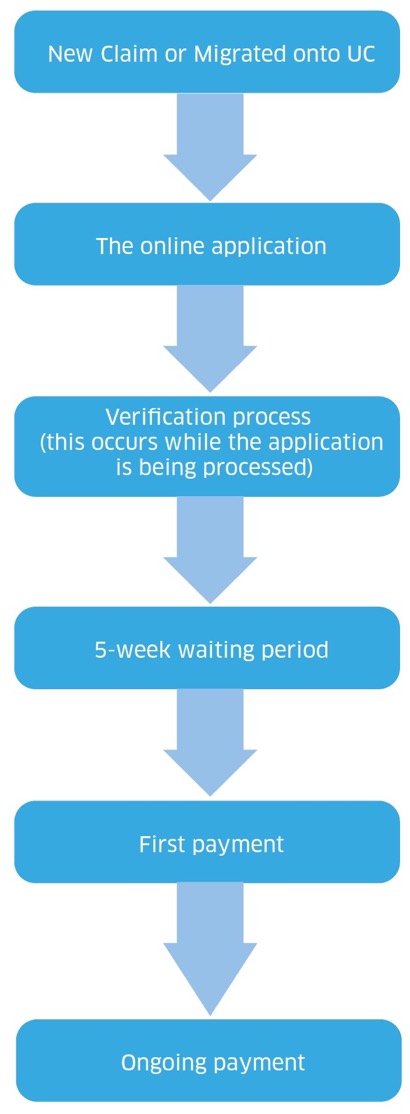
New claimants of UC are instructed to apply online through the UK Government's website. Claimants must then complete an online verification process to confirm their identity. The date the claim is submitted is referred to as the claimant's 'assessment date'. For employed claimants, the DWP will use 'Real Time Information' on earnings, provided by the claimant's employers to HRMC, to calculate the appropriate award amount. Self-employed claimants are required to report their income to DWP each month, in order for entitlement to be calculated. The DWP's target is to pay claimants within five weeks of their assessment date, which, going forward, will serve as the date each month when UC will be paid. Once the payment is made, claimants will receive a bank transfer on the same day each month as their initial application submission, or the weekday immediately before this if it is a weekend or bank holiday.
The memorandum also provided more detailed information on how managed migration will function. The memorandum proposed that:
- Before initiating the managed migration into UC, the DWP plan to allow a 4-6 month “preparation period” when claimants will be notified that their existing benefits are ending and advised on what steps to take to prepare to claim UC (p. 11).
- Once this period is over, claimants will be notified that they need to claim UC by a specific date (within one to three months) in order for their benefit payments to continue. This date is called the “deadline day” (p. 11). The notification will tell them that their benefits will be stopped on the deadline day and so they need to make a claim for UC (p. 13).
- When Tax Credits claimants with capital over £16,000 move onto UC through managed migration, they will be able to claim for 12 months (p. 30). [102] Then their UC entitlement will stop unless their available capital has reduced below £16,000.
- Where self-employed claimants move to UC through managed migration and found to be gainfully self-employed, they will be allowed a 6-month ‘grace period’ before the Minimum Income Floor is applied regardless of how long they have been in self-employment under the legacy system (p. 24).
- Claimants who are in receipt of the Severe Disability Premium ( SDP) in JSA (income-based), IS, HB or ESA (income-related) will not be naturally migrated onto UC. This is in recognition that there is no equivalent entitlement to the SDP in UC and these claimants would have the most to lose if they migrated over to UC. Therefore the legacy benefit claimants in receipt of the SDP will instead be moved onto UC through managed migration to allow them access to transitional protection. Claimants who have been naturally migrated before the regulations come into force will have a transitional protection award calculated based on the amount they would have been entitled to during their previous UC assessment periods. The amount of transitional protection they have missed out on since moving to UC will be paid as a lump sum and the transitional payment will then be paid as part of the UC award going forward.
4.4 Universal Credit Scottish choices
Sections 29 and 30 of the Scotland Act 2016 allow Scottish Ministers to introduce UC flexibilities with regard to who receives UC payments and when. These are:
- having the option of being paid UC twice a month rather than monthly;
- having the option of the UC housing element being paid directly to social and private sector landlords;
- the power to vary the amount of housing costs paid to people in receipt of UC; and
- the power to split payments between partners in a household.
If a claimant chooses twice-monthly payments, at the end of the second assessment period they will receive half of their UC award for that assessment period. Fifteen days later, they will receive the second half of their award. At this point, people with monthly and twice-monthly payments will have received the same amount – one month’s UC award. They will then receive a payment approximately every two weeks thereafter, compared to a claimant elsewhere in Great Britain who will have to wait one month for each UC payment.
Recent surveys by Housing Associations in Scotland and England found that UC claimants were more than twice as likely to be in rent arrears as people who did not claim UC. [103] In Scotland in 2017, 65% of UC claimants in social housing were in rent arrears compared to 32% of other tenants. In England, 73% of UC claimants in social housing were in rent arrears compared to 29% of other tenants. The Convention of Scottish local authorities reported that across East Lothian Council and Highland Council, which have been longest on UC Full Service, average rent arrears for those in receipt of UC are over 2.5 times the rent arrears of those on Housing Benefit. [104]
The UC Scottish choices give people more choice and control over UC payments, as well as safeguarding tenancies and preventing the build-up of rent arrears. Neither option affects the overall amount of UC that is payable.
Whilst UC claimants in the rest of the UK can access similar services provided under Alternative Payment Arrangements, this is only possible at the discretion of DWP staff and after the claimant has demonstrated financial mismanagement, incurred rent arrears and/or have been at risk of financial harm.
Of the UC claimants in Scotland, 5,800 had been offered these choices between 4 October 2017 to 31 December 2017. [105] Of that 5,800, 2,600 (45%) decided to implement a choice. 1,600 chose to be paid twice monthly and 500 chose to have the housing element of UC paid direct to their landlords. A further 500 chose to take up both of these options. The Scottish Government intends to publish further management information covering the UC Scottish choices in October 2018.
By default, UC is paid as a single payment to one household on a monthly basis. This means, in the case of joint claims from couples, the couple nominates a single bank account to which the entirety of their joint UC award is paid. The single bank account nominated by the household can be a joint account. Scottish Ministers have publicly expressed concern that the UK Government’s policy of single household payments can increase inequality in the welfare system, and act as an enabler for domestic abuse or financial coercion by one partner towards another.
The Scottish Government has committed to using Section 30 of the Scotland Act 2016 to introduce split payments in UC, with the aim of promoting dignity and respect in the welfare system, and providing everyone with an independent income.
As part of the consultation on social security (29 July – 30 October 2016), 88% of people supported payments of UC to be split between members of a household. [106] Since then, the Scottish Government have engaged with a wide range of stakeholders, including Engender, Scottish Women’s Aid, Scottish Federation of Housing Associations, and Inclusion Scotland to gather views on how best to split the UC award between partners of a household.
4.5 Transitional Protection
Transitional Protection ( TP) is an additional element of UC to compensate claimants who moved onto UC through managed migration for any difference between their previous legacy benefits award and their new UC award. Where the UC entitlement is lower, TP will be awarded to make up the difference. TP will be introduced in July 2019 and will be calculated by comparing the total household legacy benefit entitlement at the point of managed migration with the total first household entitlement of UC.
It is currently unclear exactly how long TP will be in place for and the details around the conditions under which it would end, which depend on changes in household circumstances. Historically, TP for other welfare reforms has lasted in some cases for several years. The details released by the DWP so far suggest that TP will end when either:
- current UC entitlements are greater than legacy tax credits/benefits; or
- circumstances of the claimant change significantly.
DWP have confirmed that the following changes of circumstances would end a claimant’s TP.
- A partner leaving/joining the household.
- A sustained (three month) income drop beneath the expected earnings level in the claimant commitment.
- The UC award ending (due to an increase in income, for example).
The TP calculation will ignore any sanctions or deductions to which the household is subject from their legacy benefits or tax credits. This will ensure the TP amount is based on the household entitlement at the point of transition rather than the payment amount.
The Social Security Advisory Committee’s June 2018 public consultation on draft regulations also provided some more detailed information on how TP and managed migration will function. [107] The memorandum proposes that:
- Claimants who qualified for SDP as part of JSA( IB), IS, HB or ESA(IR) awards before naturally migrating to UC will qualify for TP. UK government estimates there are around 4,000 claimants in this situation who have already naturally migrated onto UC (p. 32).
- Claimants who are receiving the childcare element of UC will not have their transitional element eroded as a result of their childcare costs increasing (p. 31).
The cost of Transitional Protection
In 2018, the OBR estimated that TP will cost UK government £0.3 billion in 2020/21, rising to £1.3 billion in 2022/23, compared to a scenario in which claimants were moved onto UC without protection. The explanatory memorandum presents a more recent DWP estimate that around 2.09 million households, comprised of 2.78 million people, will move onto UC through managed migration, as opposed to the OBR’s estimate of 1.9 million households. [108] Should the numbers migrated be higher than the OBR’s 1.9 million estimate, the cost of TP is likely to rise accordingly. The OBR estimate that the cost of TP will peak in 2022/23, and slowly decline as claimants gradually lose TP due to UC entitlements increasing beyond legacy benefit entitlement, or changes of circumstances causing their UC claim to end. [109]
The UK Government has put in place a benefits freeze which will continue until March 2020. In the absence of further policy change, the level of benefit entitlements will begin to be uprated with inflation beyond this date. Once benefit entitlements begin to increase, the difference between claimants’ UC award under TP and their flat entitlement under the legacy system will reduce.
As previously discussed, the Resolution Foundation estimated that moving onto UC will cost the average working family £625 per year. [110] Table 13 assumes that a hypothetical household is entitled to £8,000 of legacy benefits and are migrated onto UC in 2019 by DWP where their entitlement is reduced by this average of £625. If UC entitlements were linked to inflation from 2020/21 onwards, and a 2% inflation target is met each year, the family’s TP will run out in 2024/25.
Table 13 – The impact of inflation on Transitional Protection
| 2019/20 |
2020/21 |
2021/22 |
2022/23 |
2023/24 |
2024/25 |
|
|---|---|---|---|---|---|---|
| Legacy benefits entitlement |
£8,000 |
£8,000 |
£8,000 |
£8,000 |
£8,000 |
£8,000 |
| UC entitlement |
£7,375 |
£7,523 |
£7,673 |
£7,826 |
£7,983 |
£8,143 |
| Transitional Protection entitlement |
£625 |
£478 |
£327 |
£174 |
£17 |
£0 |
Source: Scottish Government calculations
It is therefore inevitable that eventually people who receive less under UC than under legacy benefits will feel the effects of this.
4.6 How Universal Credit awards are calculated
This section will explain how UC awards are calculated, TP and some aspects of how UC entitlement interacts with income from self-employment.
UC consolidates six individual legacy benefits and whilst it is a single benefit it comprises several elements, as shown in figure 4.
Figure 4 - Universal Credit entitlements
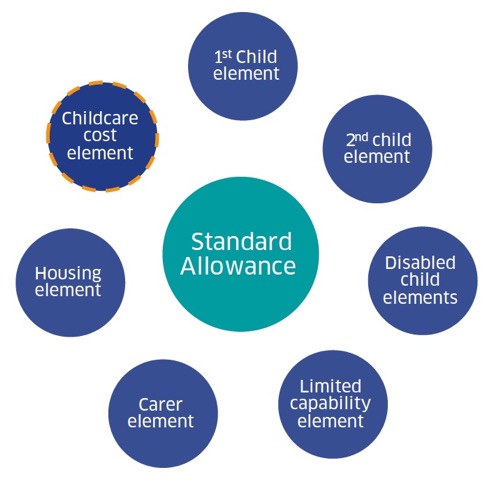
There are three steps to calculating a UC award.
1. Calculate the maximum award.
2. Adjust maximum award based on income. [111]
3. Reduce the maximum award by deductions to find the final entitlement.
Figure 5 - Universal Credit – 3 key parameters
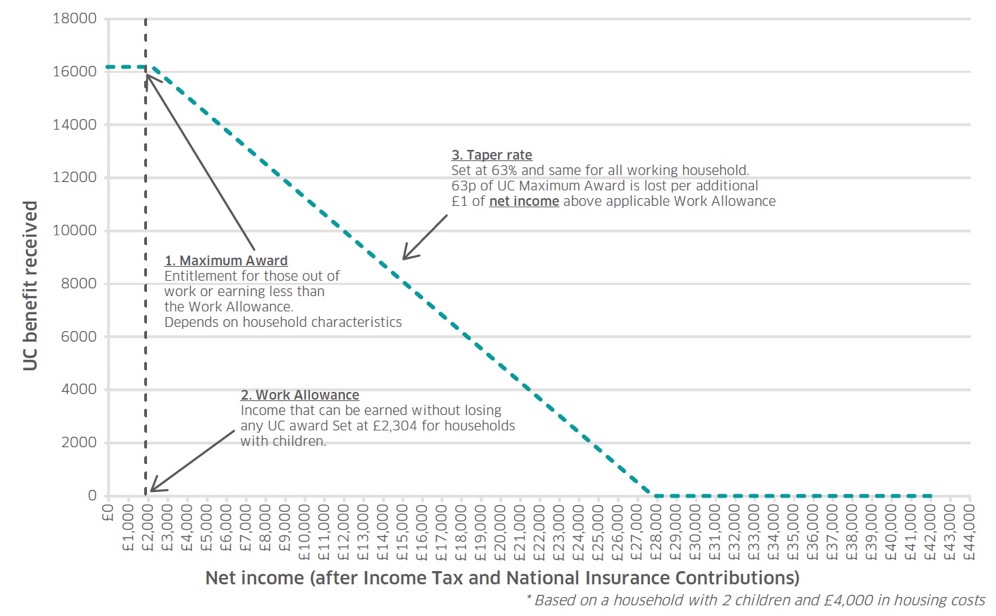
Figure 5 is a simplified illustration of how the key parameters of UC interact for calculating the UC award. Claimants who are out of work or earn less than the work allowance receive the maximum award. For every £1 of net income above the work allowance the claimant’s UC award is reduced by 63 pence for they earn. The red line in the chart above shows the tapering effect. We use a simple case study to illustrate how this calculation works in practice.
Calculating UC awards
Angela is a 23 year-old who lives alone and works 30 hours per week in a job which pays the minimum wage for under-25s of £7.38. She has a 1 year-old baby and pays £100 in childcare costs per week. She lives in social housing and pays £75 in rent per week. Under the system of benefits UC replaces, her total benefit entitlement would be around £9,400 per year, made up of Working and Child Tax Credits and Housing Benefit.
Maximum Award
To calculate her UC award we should calculate the maximum award payable, should no deductions apply. Angela would qualify for four distinct elements of UC.
- The Standard allowance - £251.77 per month.
- The Child element - £231.67 per month.
- The Childcare costs element – 85% of her £100 per week childcare costs, or £368.33 per month.
- The Housing element – Her full amount of housing costs per week, or about £325 per month.
That gives a total maximum award for Angela of £1,176.77 per month.
Work Allowance and Taper rate
The next step is to estimate Angela's award deductions, which increase with her income. Additional deduction rules, such as those made when claimants have over £6,000 in financial assets, can apply in more complicated cases. Angela makes £7.38 an hour, working 30 hours per week, resulting in gross pay of £959.40. To taper away the UC award, income after tax and National Insurance ( NI) is used.
Although Angela's income isn't high enough to pay income tax, she will pay some NI. The earnings threshold for this is £702 per month, so 12% of her monthly income between £702 and £959.40 must be paid as NI, which works out at £30.89. Her income after tax and NI is therefore £928.51.
Because she claims housing costs and is a lone parent, she is entitled to earn £198 per month before her income begins to taper from her UC award. When we take this work allowance off her monthly income, it leaves £730.51. Her maximum award is reduced by 63% of this figure, reducing it by £460.22.
Final Award
Angela's maximum award of £1,176.77 is reduced by £460.22. That leaves her final UC entitlement at £716.55 per month or £8,598.60 per year, about £800 less than she would have been entitled to under Tax Credits.
4.7 How is Universal Credit different from the legacy benefits?
UC is different from the legacy benefits in several ways: complexity of the system; waiting time for payment; generosity; self-employed claimants and conditionality.
4.7.1 Complexity of the Universal Credit system
Despite the DWP’s website requiring claimants to apply for UC online, [112] a recent DWP survey of UC claimants found that only 54% of claimants managed to claim online without help. Of the remaining 46%, around 90% completed their application online with help, usually from friends or relatives, or a Jobcentre Plus advisor. Only around 10% used the Universal Support service from local councils, a programme intended to help those who found the transition to UC difficult. Of these, 16% said the website crashed during the application process. [113]
The survey also found that only 45% of claimants managed to use the online identity verification process. Those unable to complete the online verification must then apply for an interview at a Jobcentre Plus office to complete verification in person, potentially delaying their application.
4.7.2 Waiting times
The five-week wait for the first payment after completing the UC application is relatively long compared to the legacy benefits. This five week wait is comprised of a one month assessment period and a 7 day processing period. In 2016/17, Child Benefit and Tax Credit claims were being processed within 16 working days on average, which is between three and four weeks. [114] The DWP do not publish statistics on the time it takes to process claims of most benefit types, however recent HB statistics show that in 2017/18, new claims for HB were processed within 22 calendar days on average, which is between three to four weeks. [115] The DWP’s March 2018 estimate showed that, following this waiting period, on-time payment of full benefit entitlement failed for 21% of claimants with 13% not receiving any payment. [116] When claimants do not receive their payment on time, the average wait is a further four weeks, totaling nine weeks since their initial claim.
This one month assessment period is intended to replicate the experience of waiting for a first payslip from an employer and to encourage responsible budgeting. [117] However, a prolonged waiting payment period can have adverse effects and financial implications for claimants. A survey for the Trussell Trust, an organisation that operates foodbanks across the UK, found that due to waiting for the first payment, 70% of respondents found themselves in debt, 57% experienced issues with their mental or physical health, and 56% experienced housing issues. [118] Only 8% of respondents stated their UC award covered their cost of living, which is likely to exacerbate any debt which accrues as a result of the waiting time. Around 60% of claimants requested an advance on their UC entitlement to help them manage their expenses until their first payment comes in. The 49% of respondents who had claimed an advance on their UC found it was unhelpful. The most common reasons for this were that the amount was too little, or that it had to be repaid.
4.7.3 Generosity
UC’s system of calculating awards is distinctly different from the legacy benefits. UC has different work allowances (the point after which benefits are tapered by income), taper rates, entitlement criteria and tax interactions. This means that UC award are often different from the legacy benefit awards and the direction of change depends on claimants’ personal circumstances.
The OBR estimate that the UC system will be less generous by £2.2 billion for Tax Credit recipients, £1.4 billion for ESA recipients and £0.1 billion for IS recipients. Conversely, for newly eligible UC claimants and HB-only claimants, it is estimated that the new system will be £0.7 billion more generous. It is estimated that the net effect on JSA claimants will be negligible. [119]
The Resolution Foundation estimate that while the gains and losses in the entitlement of couples with children will approximately even out in the aggregate, lone parents and non-parents will experience greater losses of £1,352 and £728 per year on average respectively, based on 2017/18 entitlements. The majority of people who rent will be better off under UC, while those who own their own home will generally be worse off. [120]
The biggest single difference is the reduction of the Work Allowance in UC and Income Threshold in Tax Credits ( TC). This is the point after which UC and TC awards will be reduced by claimant’s income. In July 2015, the UK Government announced that these would be reduced in both UC and TC. That meant that households with sincomes greater than the work allowances (£1,332- £8,808 per year under UC and £6,420 per year under TC in 2016/17) would lose up to around £2,500 per year under UC, or £1,000 under TC each year. The TC changes were reversed after they came under intense criticism, however the government implemented the UC changes. This distinction is a major component of the reduced generosity of UC, and the OBR estimate it will save UK Government £2.7 billion upon full UC roll out in 2022/23.
The OBR estimated that the second largest difference by size of impact would be the reduced generosity of disability benefits under UC. By replacing multiple disability premiums available in the older system with a single ‘limited capability for work and work-related activity’ element in UC, the OBR had estimated the government would reduce payments to disabled claimants by £2.2 billion in 2022/23. However, this estimated saving is likely to be substantially reduced, should draft regulations on TP proceed as planned. The DWP has announced that, “as UC does not have an equivalent to the Severe Disability Premium ( SDP), claimants who are receiving the SDP are likely to lose the most in monetary terms should they migrate naturally to UC”. [121] The draft regulations propose that people who qualified for the severe disability elements of Income-Related ESA, Income-Based JSA, IS or HB will not be naturally migrated onto UC. Instead, these people will move onto UC through managed migration, and therefore receive TP. There are already an estimated 4,000 people across the UK who previously qualified for SDP who have naturally migrated to UC. The amount of TP these people have missed out on since moving to UC will be paid back to them as a lump sum and a TP element will be added to their award. The regulations make no mention of people who would begin to meet the criteria for SDP after UC has rolled out, but did not have existing claims which included it. Therefore it appears these people will move onto UC, and receive less benefit income than the cohort who have experienced similar levels of disability since before UC was rolled out.
UC also introduces capital limits on claimants which did not exist under the Tax Credits system. Where claimants have combined savings or assets of over £6,000 their UC award is reduced. For each £250 (or part of £250) of capital over £6,000, the DWP will treat claimants as if they receive an additional £4.35 of monthly income and their award will be tapered accordingly. This continues for each £250 above £6,000, until the claimant’s capital reaches £16,000 at which point they will lose UC entitlement altogether. The OBR estimate this will save the UK Government around £200 million in 2022/23. [122]
One important change that increases the generosity of UC is the removal of the 16 hours work requirement. Under the legacy system, lone parents and disabled people needed to work at least 16 hours per week to qualify for Working Tax Credits. By removing this requirement, UC becomes more generous for people working less than 16 hours per week, in the absence of any other differences in their circumstances. The estimated net cost of this change to UK government is £1.4 billion in 2022/23.
UC is also more generous in that it covers up to 85% of childcare costs, rather than up to 70% under Tax Credits. This change will cost the UK Government an estimated £0.3 billion. However a DWP survey found that only 57% of claimants with children knew they could claim childcare costs through UC. [123] Around two thirds of those with formal childcare costs claimed them, though 42% of these said they were unsatisfied with the process. Under UC, childcare costs are paid in arrears. However many childcare providers request payment upfront before accepting a child for childcare. Parents must therefore find some other way to cover these costs when starting a new job, which can leave them in a financially precarious situation. [124]
Another large cost for the UK Government results from increased take-up rates. By combining benefits into one it makes it impossible for claimants to claim only part of their benefit entitlement, as could happen under the legacy benefits. For example, before UC, an individual could potentially claim Tax Credits but not HB despite being entitled to both. By rolling benefits together, the UK Government ensures that people in these circumstances will receive their full entitlement, at an estimated cost of £2.6 billion in 2022/23.
4.7.4 The Minimum Income Floor and Surplus Earnings
The Minimum Income Floor ( MIF) and Surplus Earnings ( SE) are two rules which can reduce the amount of UC claimants are entitled to. MIF affects only self-employed people. SE can affect employed people as well, but is particularly likely to affect the self-employed because they are more likely to have incomes which change from month to month.
The Minimum Income Floor ( MIF)
Claimants who have been gainfully self-employed for over 12 months [125] are treated as having gross earnings equivalent to 35 hours per week at the national living wage, even if their earnings are less than this level. This means that claimants with fluctuating monthly income (as can be the case for self-employed people) could receive less UC than claimants who earn the same income in a more stable pattern. The MIF policy will significantly reduce the UC awards of self-employed people with fluctuating income. We use a simplified case study to explain how the MIF could work in practice.
Minimum Income Floor
Sandy is a 40 year-old self-employed gardener and made £12,970 after tax, which is around the annual income of someone who works 35 hours per week at the national living wage.
His work is seasonal and he makes most of his money during spring and summer. Because of this, in some months he earns less than someone working 35 hours per week at the national living wage, which would pay approximately £1,081 per month, after tax
When that happens, the DWP will treat Sandy as if his income was the MIF of £1,081 per month. When Sandy earns more than the floor, his actual earnings will be used to calculate how much UC he should get. To calculate Sandy's UC entitlement, the DWP will add up his real income in months where he made more than £1,081, and substitute the MIF of £1,081 for his actual earnings in months where he made less than the MIF. That would come to a net pay of £16,566 for the year instead of his actual earnings of £12,970. The DWP will treat him as earning this £16,566 after tax when calculating his UC payment. The combined orange and blue area in the chart below represents the income level used by the DWP to calculate Sandy's award.
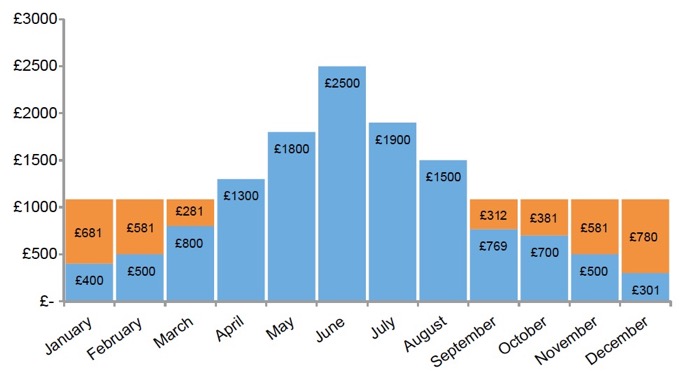
The MIF policy will significantly reduce the UC awards of self-employed people with fluctuating income. In 2018, the OBR estimated that 430,000 people will be affected by this rule after full roll out of UC. Using a Scottish share we estimate that between 30,000 and 40,000 people in Scotland are likely to be affected by the MIF. [126] The total loss of income to affected claimants is likely to be in the range of between £90 and £120 million per year. On average, those affected by the policy are expected to receive around £3,000 less than they would receive if the MIF were not in place. By 2022/23, the OBR estimate that UK Government will save £1.3 billion per year as a result. Concerns over the negative impact this policy may have on self-employed people has led the House of Commons Work and Pensions Committee, among others, to criticise the policy. [127] The Committee said the MIF “does not get this balance right” [between supporting entrepreneurship without subsidising unprofitable self-employment] and “risks stifling viable new businesses”. [128]
Surplus Earnings ( SE)
SE reduces the awards, over several months, of self-employed claimants who temporarily make larger sums of money. SE is more complicated than the MIF, which has led the Social Security Advisory Committee, among other commentators, to express their concern that claimants will not fully understand it. [129] When discussing SE, the Low Incomes Tax Reform Group stated that “These are some of the most complex rules we have ever seen and we doubt that DWP staff or claimants will be able to fully understand and implement them. [130] ”
We use another simplified case study to explain how it works.
Surplus Earnings
Sonya is 30-year old with a 5-year old child. She runs a small business which makes £1,200 net profit after tax selling arts and crafts in a normal month. Sonya's UC maximum amount in a given month is £979. After tapering her UC award by her net income of £1,200 she receives £348 of UC each month.
In August she makes £5,800 net profit after tax selling her crafts at the Edinburgh festival. This is too much to receive UC, therefore her UC claim will stop. The cut-off point when Sonya's net income would reduce her UC entitlement to 0 is £1,752. The DWP refer to this as her 'nil UC threshold'. Her August net income was £4,048 beyond the £1,752 threshold. This £4,048, minus a isregard of £300, is called her Surplus Earnings. The DWP will use Sonya's SE to reduce her UC entitlement in later months.
The Surplus Earnings policy offers Sonya two choices.
1. Stop claiming UC for six months. After six months any remaining SE will be forgotten and she can claim UC normally.
2. Submit a new claim every month until her SE run out.
To work through this example, we assume Sonya chooses the second option. The charts below show what would happen to her UC entitlement and Surplus Earnings as a result.
Sonya's UC Entitlement
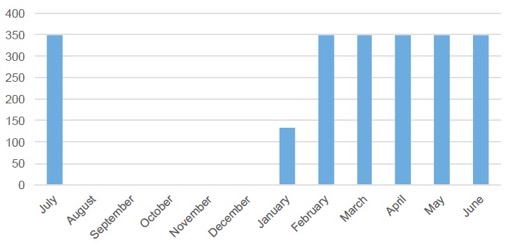
Sonya's monthly income (blue) and Surplus
Earnings (red)
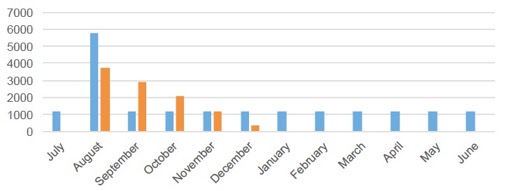
Surplus Earnings (continued)
Sonya will need to continue making UC claims each month from September to November even though she will not receive any UC award. Each month she applies, her SE will be reduced by the £1,752 threshold, plus a £300 disregard. Then her earnings for that month are added on. So each month until Sonya gets paid, her SE reduce by (£1,752 + £300 - £1,200) = £852. Once her SE have run out in December she will start receiving UC payments again.
It is important to note that the calculation in the above example would be more complicated for claimants receiving more complex elements of UC, or with less predictable income. [131] Unlike the MIF, the SE policy can also apply to employed people who have an income above their “relevant threshold in a particular month”. This case study focuses on the effect on self-employed people, because for many small businesses a degree of income volatility is difficult to avoid.
In their 2018 report, the Social Security Advisory Committee were “not convinced that this proposal can be satisfactorily implemented in a way that is clear and fair to claimants”. [132]
4.7.5 Conditionality
Under UC, the conditionality regime has become more stringent than the legacy system. In the legacy system, only claimants of JSA, ESA (Work-Related Activity Group) and IS can receive sanctions. Tax Credit and Housing Benefit awards are not subject to sanctions. Under UC all claimants, including those already in work, must accept a ‘Claimant Commitment’ which sets out what they must do to continue to receive benefit payments, which may be preparing for work, looking for work or increasing their income if they earn less than the DWP’s requirements. [133]
The DWP have estimated that “around a third of UC cases will be subject to work-related requirements when UC is fully rolled out, of which half will be full conditionality and half will be less demanding regimes.” [134] Some of the UC claimants, subject to conditionality never experienced this under the legacy system. For example, the OBR estimate that upon full roll out, conditionality will affect:
- 300,000 former child tax credits and housing benefit claimants that don’t currently experience conditionality;
- 300,000 former ESA claimants who will experience additional work-preparation requirements;
- 150,000 former ESA claimants who will experience full conditionality; and
- 450,000 new claimants who didn’t previously claim means-tested benefits.
UC Conditionality Regimes
Claimants of UC can fall into a variety of Conditionality Regimes, based on their circumstances. Some UC claimants will be exempt from work-related conditionality, and so come under the ‘no work requirements’ group. [135] The DWP define the conditionality regimes as follows:
Table 14 – Universal Credit Conditionality Regimes
| Conditionality Regime |
Description |
Scottish UC claimants in June 2016 (% share of total) |
Scottish UC claimants in June 2018 (% share of total) |
|---|---|---|---|
| Searching for work |
Not working, or with very low earnings. Claimant is required to take action to secure work - or more / better paid work. The Work Coach supports them to plan their work search and preparation activity. |
21,091 (68%) |
50,465 (51%) |
| Working – with requirements |
In work but could earn more, or not working but has a partner with low earnings |
2,345 (8%) |
12,983 (13%) |
| No work requirements |
Not expected to work at present. Health or caring responsibility prevents claimant from working or preparing for work. |
581 (2%) |
14,192 (14%) |
| Working - no requirements |
Individual or household earnings over the level at which conditionality applies. Required to inform DWP of changes of circumstances, particularly if at risk of decreasing earnings or losing job. |
6,851 (22%) |
16,886 (17%) |
| Planning for work |
Expected to work in the future. Lone parent / lead carer of child aged 1. Claimant required to attend periodic interviews to plan for their return to work. |
77 (0%) |
1,549 (2%) |
| Preparing for work |
Expected to start preparing for future even with limited capability for work at the present time or a child aged 2, the claimant is expected to take reasonable steps to prepare for work including Work Focused Interview. |
85 (0%) |
3,239 (3%) |
As discussed in section 3.2, during the early stages of UC roll out a large share of UC claimants were out-of-work single people with no dependents. This is changing over time as more complex benefit cases enter the system, which will reduce the share of claimants in the ‘searching for work’ group.
In-work conditionality under UC
In-work conditionality is a new feature introduced with UC with the aim to improve in-work progression. In-work conditionality requires the claimant to increase their earnings by increasing their hours of work or moving to better paid jobs. For example, a claimant working 16 hours a week who is judged to be capable of working 35 hours can be asked to demonstrate they are actively trying to increase their hours. However evidence that UC in-work conditionality supports in-work progression is very limited. For some people facing wider barriers to employment, such as caring responsibilities or high childcare costs, UC may not adequately account for these barriers, while the sanctions imposed under UC conditionality can have a detrimental impact. [136] In addition, under UC in-work conditionality self-employed claimants are required to be ‘gainfully’ self-employed. DWP’s Work Coach can come to a view that self-employment is not the most appropriate way for the claimant to become financially independent and the claimant will then be expected to look for work. [137] The illustrative example below shows how in-work conditionality can be applied.
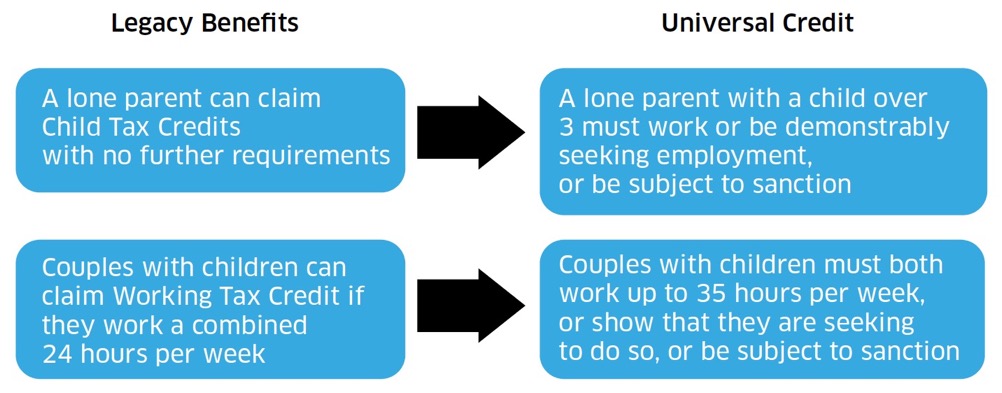
If the Work Coach decides that the claimant has failed to meet the conditionality requirements, then a sanction is imposed reducing the claimant’s payment. UC sanctions come in four levels: high, medium, low and lowest. The category of sanction determines the duration the payment reduction will apply. Figure 6 shows for each sanction level: the number of people sanctioned in Scotland, the share of all sanctions, the possible duration of sanctions and the actions which can lead to them.
Figure 6 – The number of sanction decisions made in Scotland from August 2015 – January 2018 by sanction level, minimum duration and the actions causing the sanction.
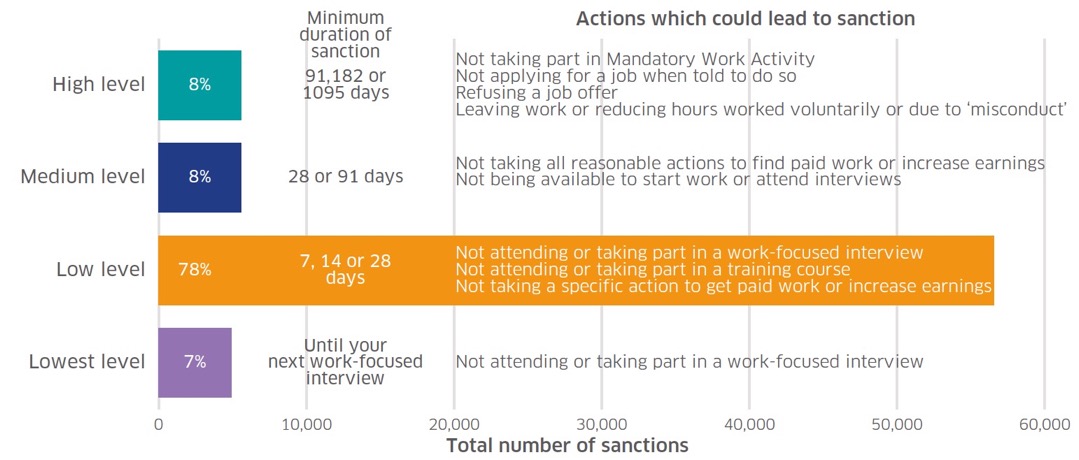
Source: Stat Xplore – UC Sanctions Decisions data
Most sanctions since the roll out of UC have been at the low level. These low or lowest level sanctions will last from the day they failed to comply with a work-related activity until the claimant complies with the work-related activity required, or the requirement no longer applies. At the low level, the claimant’s first sanction will last a further seven days after the claimant complies with requirements. If it is a second sanction it will last a further 14 days after the claimant complies, and 28 if it is the third. Higher level sanctions last progressively longer, and can last a maximum of 1,095 days i.e. three years.
Should a sanction be imposed, the financial penalty is referred to as the Daily Reduction Rate. Claimants experience the low rate if they come under the Planning for Work or Preparing for Work groups, otherwise the high rate applies. The high rate reduces UC by up to £10.40 per day, while the low rate reduces UC by up to £4.10 per day.
Impact on employment
The DWP’s full business case assessment estimated that, as a result of UC conditionality, 30,000 additional individuals will be in work. [138] However, the OBR described the evidence of the employment impact of conditionality and sanctions effect on employment as “mixed”, suggesting that there was not sufficient evidence to judge how claimants’ labour market outcomes might yet change. [139] In November 2016, the National Audit Office reported that the DWP did not track the costs, such as hardship or depression, or benefits, such as potentially increased employment, of sanctions and concluded that the “department does not know these wider costs and benefits”. [140]
A recent longitudinal study on welfare conditionality found that “movements into sustained employment and progression within the workplace were very rare”. [141] The report found that “respondents commonly regarded Jobcentres and Work Programme providers as being primarily focused on ensuring compliance with the mandatory benefit claim conditions rather than helping people into work.” Benefit sanctions “were routinely experienced as punitive and more likely to undermine the likelihood of engagement or advancement in paid work.” [142]
Impact on food insecurity
Despite repeated warnings from charities, in 2015 the UK government maintained the position that there is no robust evidence that directly links sanctions and food bank use. [143] Some evidence suggests that a potential explanation for this could be that the DWP has chosen not to record data on the number of people using food banks. [144] A recent FOI request showed that Jobcentre Plus staff are explicitly told not to use foodbank referral slips records to count the number of referrals made. [145] The most recent of a number of studies found that for every 10 adults per 100,000 sanctioned in a Local Authority area, the number of people using food banks increased by 3.36 adults per 100,000. [146] A further study found benefit sanctions and other changes in benefit payments were the main reasons for the income reductions that led people to resort to food banks. [147]
Impact on destitution
A Joseph Rowntree Foundation’s study found that in 2016, the income-related factors that caused destitution tended to be “benefit delays, sanctions or other interruptions”. [148] The survey findings suggest that 30% of destitute people had experience of benefit sanctions in the last 12 months, and 40% had experienced benefit delays.
Impact on mental health
Imposing benefit conditionality on single mothers was shown to damage their mental health in a 2018 study. [149] The annual report of the Chief Medical Officer for Scotland reported evidence showing the UK Government’s new welfare sanctions regimes had a “potential adverse impact on mental health“. [150]
As well as more benefit claimants being subject to conditionality under UC than under legacy benefits, the proportion of UC claimants who receive sanctions is also far higher than the share of the JSA, ESA and IS claimants who received sanctions under the previous system. This is shown in Figure 7.
Figure 7 – Sanction rate of Universal Credit, JSA, ESA and IS claimants across Great Britain since August 2015
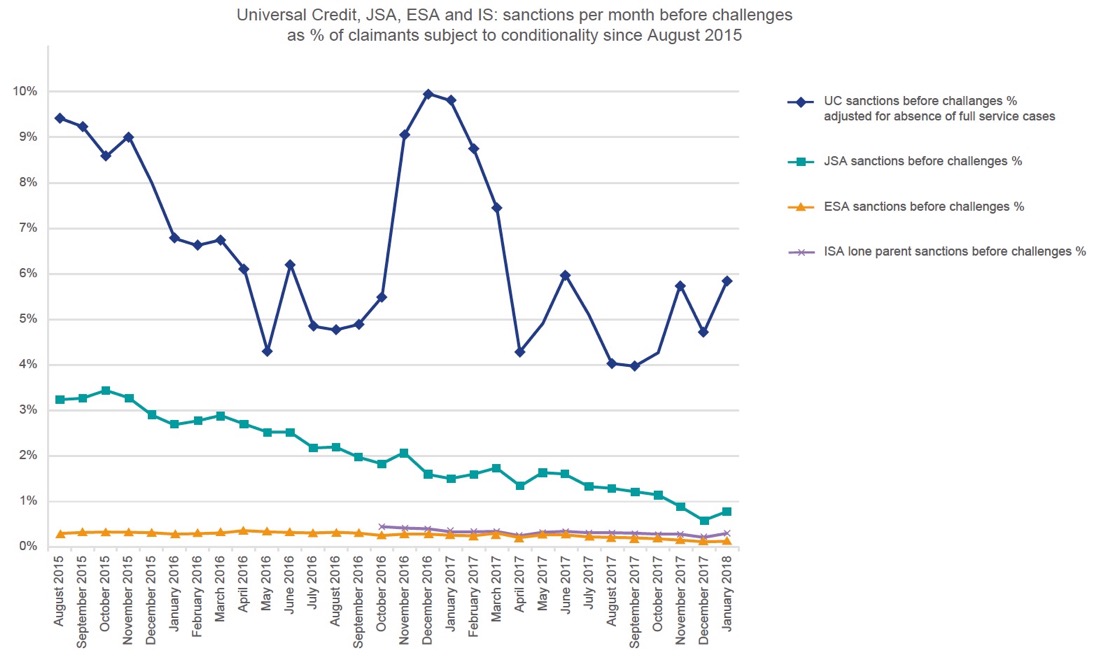
Source: Child Poverty Action Group [151]
As of February 2018, UC claimants are over six times as likely to be sanctioned as claimants of JSA. People in the ‘Searching for work’ group, who are unemployed or have low employment income, are particularly likely to be sanctioned. Across Scotland, 2,900 people in the ‘searching for work’ group were sanctioned in February 2018, compared to 200 in all the other groups combined. They therefore accounted for 93% of sanctions while accounting for only 56% of claimants. This disparity in sanction rates is shown in figure 8.
Figure 8 – Universal Credit Sanction rates of ‘Searching for work’ group against combined sanction rate of all other groups over time
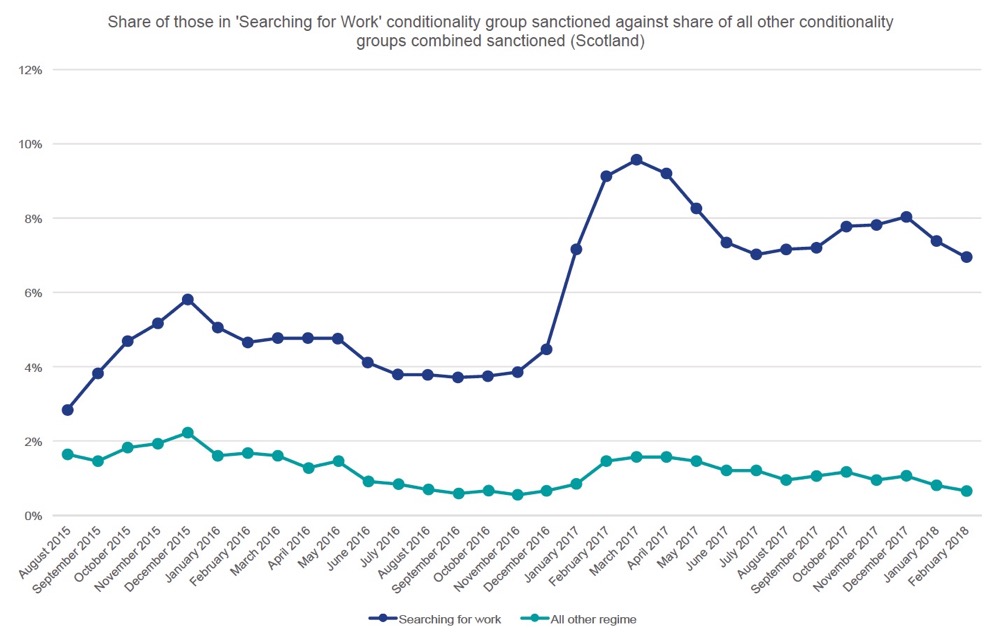
Source: Stat Xplore
It should be noted that the second most likely group of claimants to be sanctioned are working people with requirements. The most recent data shows around 2% of this group are sanctioned each month. These people are employed and may have met the eligibility criteria for the legacy system, however under UC they face the prospect of financial penalties.
A significantly greater share of men than women have been sanctioned every month since data collection began in August 2015. In the most recent February 2018 data, the share of men sanctioned (5.5%) was 2.5 times higher than the share of women sanctioned (2.2%). There is also an distinctive trend for younger people to be sanctioned more often than older people. Figure 9 shows the sanction rate of different age groups in Scotland over time.
Figure 9 – Universal Credit Sanction rates of different age groups over time in Scotland
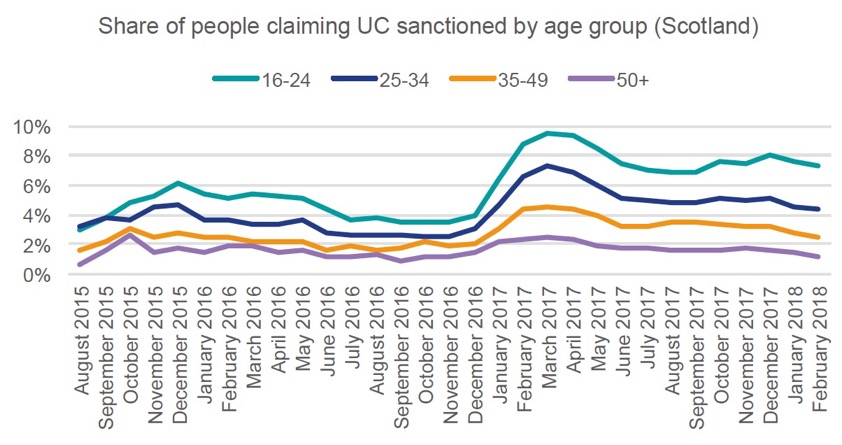
Source: Stat Xplore
Of Scottish men aged under 24 in the UC searching for work group, 14% were sanctioned in the most recent February 2018 data. Among the 40 to 65 age group, the sanction rate was 3%. Young people, particularly those who are unemployed, are less likely to have the financial assets which can prevent destitution when their incomes fall.
In their 2016 review of DWP sanction regimes, the National Audit Office noted that “the available evidence suggests the Department’s use of sanctions is linked as much to management priorities and local staff discretion as it is to claimants’ behaviour.” [152]
Fair Start Scotland
The Scottish Government has long raised its concerns over the UC conditionality and sanctions regime with the UK Government. Building on the success of transitional services Work Able Scotland and Work First Scotland which operated in 2017/18, in April 2018 the Scottish Government introduced Fair Start Scotland, which is a new Scottish employability service aiming to support a minimum of 38,000 people who want help to find and stay in work and for whom work is a reasonable objective. Fair Start Scotland, will have respect and fairness at its core, supporting people to achieve their full potential.
Crucially, people’s participation in Fair Start Scotland will be voluntary. It will work with unemployed people to help and encourage them to see employment support as an opportunity, rather than being driven by the threat of financial sanctions.
Contact
There is a problem
Thanks for your feedback